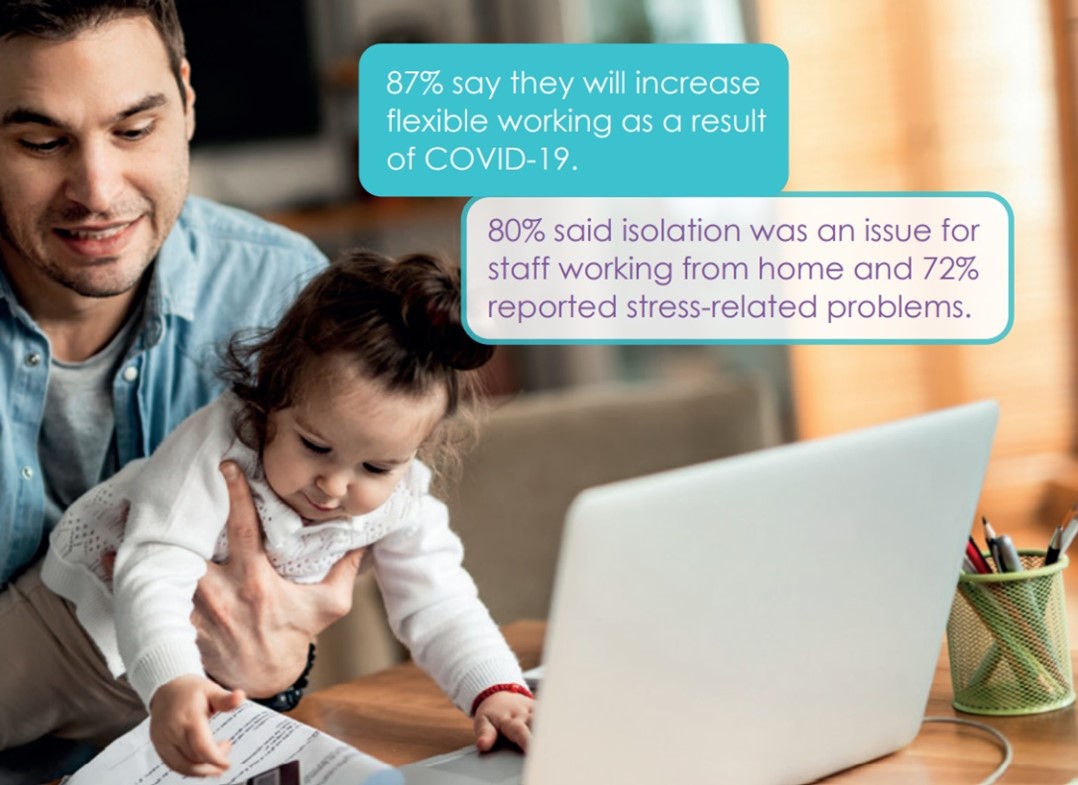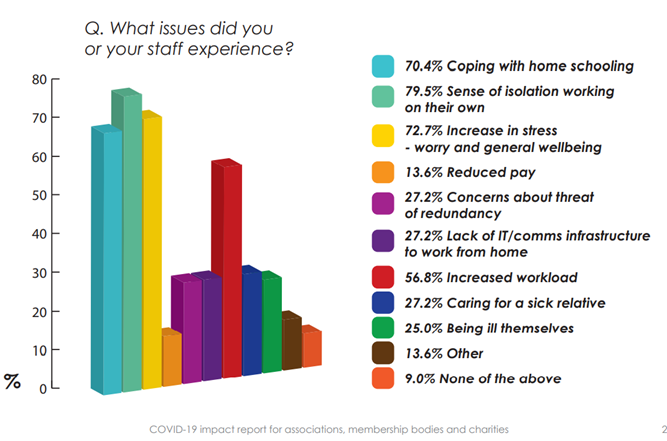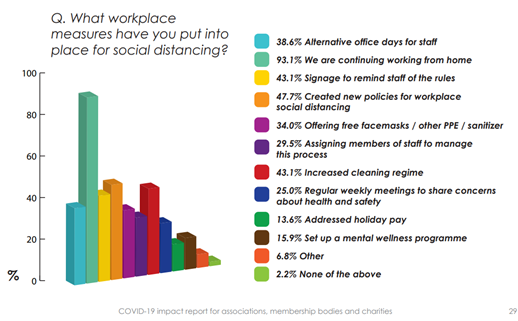By Gordon Glenister, CEO of Gordonglenister.com
I was commissioned to complete extensive research into the impact of Covid-19 on membership bodies and trade associations which were surveyed. The results of this work highlighted a number of fascinating insights into how we have been affected by the Pandemic which were summarised in a report. In a series of four newsletter articles written for the Trade Association Forum, I will talk about some of these highlights with extracts from the report. The first in our series takes a look at the impact of working from home has had on our employee welfare.

According to a survey conducted by HR software provider Breathe in conjunction with Posture People and HR Central, 88% of people are worried about using public transport to commute during the coronavirus outbreak. Given this statistic, it has been an easy decision to allow employees to work from home. Enabling this has been a major achievement for many associations and considering that our staff have faced the challenges of isolation, home schooling, multiple residents being online at the same time, partners facing illness or redundancy and increased workload, the sector has nevertheless managed to work extremely well.
In fact, the level of staff engagement has been higher than before, with Chief Executives reporting that they wouldn’t previously have been able to talk to entire teams at once, but through necessity technology has now made this possible in a way in which we would not have considered before. It has also been easier to communicate what the association is doing to all employees.
Some organisations expressed concerns around data and potential breaches, particularly in relation to sharing of personal data and the Data & Marketing Association was in regular communications with government and the Information Commission Office in relation to obtaining advice on this.
The findings indicated that whilst some employers had previously been worried about flexible home working and being able to manage projects effectively, actually the reverse has happened. Productivity levels have been extremely high, helped by the sense we are ‘in this together’ and need to support each other. A number of companies noted that staff being able to work in their own environment without distractions has been hugely beneficial to them. Where employees had not coped so well, employers offered counselling services to help with this with 16% of respondents setting up a more formal employee wellness programme.
Stephen Woodford, CEO of the Advertising Association compared the number of meetings he would have attended pre-lockdown to now. Previously it was 16 and now it is 30. There is also a greater appreciation of what colleagues do. He said: “We know more about people now than we did when they were sat next to us at their desks because we get to see everyone’s outputs.”
The downside of having constant access to work emails and platforms such as Zoom, is too much focus on PC time, and employers have been conscious of trying to ensure that their teams take adequate breaks and exercise.

Chris Combemale from the DMA, said he wanted to lead by example and take two hours out in the middle of each working day: “I structured my diary so I could start early and finish later, allowing for a longer break in the middle of the day.”
Ben Beadle from the National Residential Landlords Association talked about creating a Family First policy and the importance of using regular anonymous surveys on employee wellbeing, as well as allowing contributions for new ideas. He uses a platform called Peakon, but there are others in the marketplace many of which have seen a rise in usage. Adrian Christy, CEO of Badminton England, said “If the team wanted to they could work at different times of the day to accommodate home schooling.”
In terms of returning to work, organisations have followed Government guidlines and put appropriate social distancing measures in place to ensure that their staff are safe. 39% of respondents said that they have operated an ‘alternate office days’ policy to allow staff to break up the week and have some colleague contact if they wanted to, though some 93% are continuing to work from home for now. The Chartered Institute of Public Relations and the Branded Content Marketing Association have made the conscious decision not to renew their office locations and will now permanently work from home, but with the opportunity for staff to come to London once a month for get-togethers and team meetings. One association has saved £70,000 a year by moving to a smaller Regus London office. 40% of respondents have written new staff employment policies to cater for the changing environments at home for the newly created self-distanced work environment. 34% have provided free facemasks and hand sanitisers for all staff and 43% have implemented new cleaning regimes. 43% have increased signage to make sure rules around social distancing are clearly shown and are properly observed.

Keeping Teams Motivated
There have been all sorts of ways in which organisations have tried to keep teams motivated throughout the pandemic. These have included Monday stand-up meetings, yoga, wine tastings, baking, Friday night get-togethers and quizzes to name a few. CIM ran a ‘whose desk is it’ quiz and Fitness Tuesdays. The Chartered Institute of Patent Attorneys organised its own version of the TV show ‘Taskmaster’. One Zoom meeting at the National Association of Estate Agents featured a magician which proved popular. Lockdown has been a time when it has been okay to make mistakes and try out new technology, when everyone from the CEO to hye more junior staff members have faced the same challenges. Everyone has dressed more casually and gotten a peek into their colleagues’ homes and lives, and this has created a level of transparency and authenticity that may not have been achieved without the pandemic.
Home working for the forseeable future has for some worked out very well. The National Association Estate Agents remarked that one of their members has seen that homes with purpose built office space are now being snapped up swiftly when previously they would have taken some time to sell. This translates also to an increase in enquiries for property with permanent outdoor buildings for office use.
Despite these benefits, there is no doubt that we have greatly missed direct human interaction and whilst technology has helped us become more efficient, nothing replaces a face-to-face dialogue and a collaborative working approach. From this, we can conclude that we will likely see a more hybrid approach to this new way of working in the future and as the pandemic eventually eases to allow for more freedom of movement, we will see a more interactive in-person way of working come back into our daily lives to complement the advantages of conducting our work online.
For the second article in the series, I will take a look at how associations approached their communications activity with their members and other stakeholders during the Covid-19 outbreak.
About the Author
Gordon Glenister was in a past life the CEO of the British Promotional Merchandise Association. He is now a membership and association consultant, podcaster and author of influencer marketing strategy. He is also the founder of membershipworld a community and podcast site for membership professionals. For a copy of the full impact of the Covid-19 report click here.
